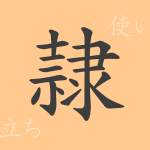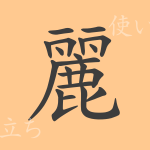The kanji ‘齢 (れい, よわい)’ is deeply intertwined with our daily lives. We use this character when asking about age or contemplating the meaning of growing older. However, its origins and rich meanings are not widely known. In this article, we will delve into the etymology of ‘齢 (れい, よわい)’, its usage, readings, stroke count, radical, and the idiomatic expressions and proverbs that include this kanji.
Origins of 齢 (れい, よわい)
The kanji ‘齢 (れい, よわい)’ has ancient origins, with its form and meaning spanning thousands of years. Originally, this character depicted the image of teeth growing in the mouth, symbolizing growth and age. In ancient China, there was a custom of estimating a person’s age by their teeth development, making ‘齢 (れい, よわい)’ a character that precisely represents this process.
Meanings and Usage of 齢 (れい, よわい)
The kanji ‘齢 (れい, よわい)’ is primarily used to denote age. Specifically, it is often used to indicate a person’s age or the number of years something has existed. Additionally, it can be used metaphorically to describe stages or periods in life, such as in the expression “the autumn of life.”
Readings, Stroke Count, and Radical of 齢 (れい, よわい)
The kanji ‘齢 (れい, よわい)’ has distinctive readings and structure.
- Readings: The on’yomi (音読み) is ‘レイ (れい)’, and the kun’yomi (訓読み) is ‘よわい (よわい)’
- Stroke Count: It has a total of 17 strokes
- Radical: The radical of 齢 (れい, よわい) is ‘齒 (は, はへん)’
Idiomatic Expressions and Proverbs Using 齢 (れい, よわい)
There is a wealth of idiomatic expressions and proverbs in Japanese that include ‘齢 (れい, よわい)’. For instance, ‘年齢 (ねんれい, age)’ not only indicates the number of years but also can imply social experience and maturity. The idiom ‘厭世齢 (えんせいれい)’ describes an age or mindset where one feels disillusioned with the world. Additionally, the phrase ‘花の齢 (はなのよわい)’ is used to express a period of youthful beauty.
Conclusion on 齢 (れい, よわい)
The kanji ‘齢 (れい, よわい)’ is a character commonly used to represent age and growth in our daily lives. Its origins, structure, and meanings are profound, and it is utilized in various expressions in the Japanese language. Understanding ‘齢 (れい, よわい)’ and mastering its usage can enrich one’s appreciation of the Japanese language. Through this kanji, we can not only perceive age but also the milestones and beauty of maturity in life.

























